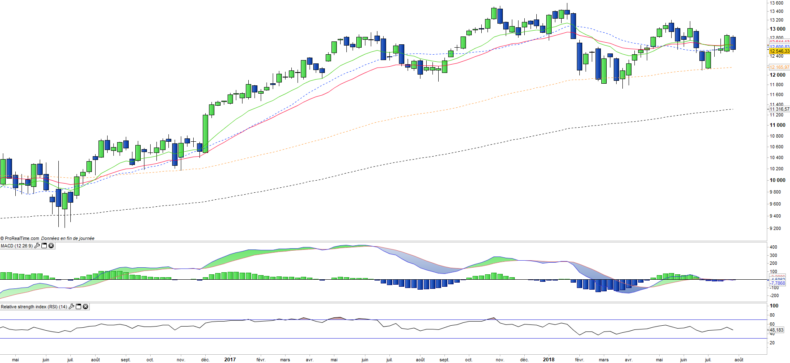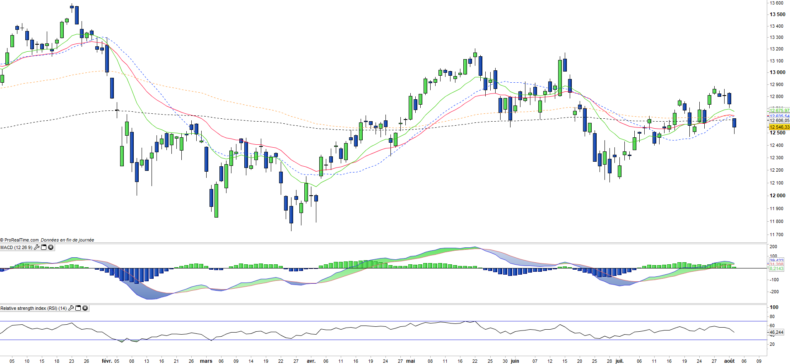Lyxor DAX - DAX - 03/08/2018
Short Term strategy: Negative (30%) / Trend -
Long Term strategy: Neutral (50%) / Trend -
pour accéder à nos achats / ventes sur les indices
Characteristics of the ETF
The DAX ETF (Lyxor), quoted in Euro, replicates the DAX 30 index which is composed of the 30 largest listed German securities, representative of the main sectors of the economy, while the stocks are selected according to the importance of their market capitalization.
The costs of this ETF are low at 0.15% and AUM is quite high at 968M €, which makes it a good vehicle in terms of costs / liquidity. The replication method is direct (physical) and the dividend distribution is capitalized.
Alternative ETFS: DBXD (DB-x Tracker in Euro), DAXEX (iShares in Euro)
Index & components
The top 10 stocks are mainly large industrial stocks such as Siemens or Bayer, while there are only 3 financial stocks: Allianz, Commerzbank and Deutsche Bank, the German master index is relatively small and mostly composed of large industrial groups. Unlike the English, French or Italian indices, the DAX is also distinguished by the absence of large oil companies that weigh heavily in the weighting of the CAC40, FTSE100 or FTSEMIB40, which is double-edged according to the cycle specific to energy sector. In addition, the financials weigh only 16,1% of the index, half for the insurance giant Allianz, so the banking sector has a low weight reflected in the well-known weakness of Deutsche Bank and Commerzbank. Conversely, the automotive and chemical sectors are heavier than the other European indices, while the technology sector is mainly represented by SAP (9.8%) whose market capitalization exceeds € 100 billion.
In summary, the DAX is a fairly strong index from a sectoral point of view which can make it evolve differently from other European indices. German fundamentals are very solid (GDP growth above 2%, historically low unemployment rate at 5.5% and accelerated deleveraging up to 2020).
The main risks concern Germany's main customers, namely the United Kingdom, which could suffer from Brexit, the US in political uncertainty and threatening it with a trade war, Russia which remains a difficult and aggressive neighbor and China because of its commercial practices which also tend to limit access to its domestic market to Western industrialists, particularly in the automotive and technology sectors.
Latest developments
After an increase of 6.9% in 2016, the DAX30 grew by 12.5% in 2017, more than the stoxx600 (+ 10.6%). But the index has fallen -1.4% since the beginning of the year, which is a lower performance than the Stoxx600NR (+ 2.3%), which is mainly related to the risks of trade war with the US. The German economy is based on exports and has everything to lose in a trade war and the general increase of tariffs.
The meeting between D. Trump and JC. Junker of July 25 has allowed to delay and clear lines of compromise for a trade agreement between the US and Europe which must be confirmed otherwise the US has warned they would apply a 25% tax on European imports. The 3 largest German manufacturers account for around 10% of the capitalization of the DAX and would be particularly affected by the application of this tax.
Weekly data
On the weekly chart, we can see that after the double bottom of prices on the EMA100 the index is trying to rebound again but remains locked under a bearish line in the short term. The level of 13000 pts remains key to the continuation of this rebound. Conversely, the key to the medium-term trend remains the EMA100 which is the main support. In case of bearish break out of the latter, the trend would pass negative.
ETF Objective
DAX is a UCITS ETF, listed in EUR, which seeks to replicate the german DAX index (30 companies)
Chacracteristics
| Inception date | 01/06/2006 |
| Expense ratio | 0,15% |
| Issuer | Lyxor |
| Benchmark | DAX 30 index |
| Code/Ticker | DAX |
| ISIN | LU0252633754 |
| UCITS | Yes |
| Currency | € |
| Exchange | Euronext |
| Assets Under Management | 963 M€ |
| Replication Method | Direct (Physical) |
| PEA (France) | Yes |
| SRD (France) | Yes |
| Dividend | Capitalization |
| Currency Risk | No |
| Number of Holdings | 30 |
| Risk | 3/5 |
Country Breakdown
| Germany | 100% |
Sector Breakdown
| Consumer discretionary | 16% |
| Financials | 16% |
| Materials | 15% |
| Health Care | 14% |
| Industrials | 14% |
| Information Technology | 12% |
| Telecom services | 5% |
| Others | 8% |
Top Ten Holdings
| Siemens | 10% |
| SAP | 10% |
| Bayer | 8% |
| BASF | 8% |
| Allianz | 8% |
| Daimler | 5% |
| Deutsche Telekom | 5% |
| Linde | 4% |
| Adidas | 3% |
| Deutsche Post | 3% |


